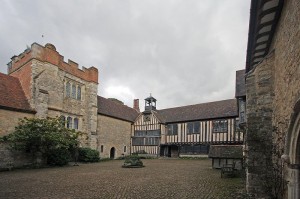Ightham Mote is a wonderful medieval moated manor house in Kent owned by the National Trust and described by David Starkey as ‘one of the most beautiful and interesting of English country houses’.
It was built in the early 14th century and although it has undergone several alterations and additions over the last 700 years ‘thoughtfully blends later periods of architecture into a scheme that is in no way jarring or evasive’ (Kettler & Trimble, Pg. 84).
The oldest parts of the home are the Great Hall, crypt, Old Chapel and two solars.
Between 1487 and 1519 Edward Haut enclosed the courtyard and built the cottage range; Sir Richard Clement (1521-38) went on to decorate the home with Tudor symbols including the stained glass in the Great Hall and the magnificent ceiling in the Chapel.
It is said that the paintings in the chapel were created in preparation for a visit from King Henry VIII and Queen Catherine of Aragon.
As if picturesque courtyards, an ancient Great Hall and a magnificent Tudor chapel aren’t enough to entice you, Ightham Mote is also home to the only Grade 1 listed dog kennel!
This wonderful property is a worthy stop On the Tudor Trail.
Click here for opening times and admission costs.
[cincopa AIAAWraGtUpz]
Sources National Trust Ightham Mote Kettler, S. & Trimble, C. Medieval and Tudor England: Day Trips South of London, 2002. Photos courtesy of Wikimedia Commons.

















Have you ever read Anya Seton’s Green Darkness Natalie? The book is set at Ightham Note, and deals with the story of a young woman who was bricked up in a wall in the house, a story that Anya heard when she was touring the house.
Hi Elizabeth, I haven’t read that yet but it sounds like something I would enjoy. I’m off to search for it now, thank you for sharing this!
Oh, that does sound like a great book–I’ll check it out. What a beautiful place! Thanks!
I have several pages of notes on Ightham Mote and some wonderful water-coloured sketches in a book on Old Manor Houses by Cecil Aldin, who stayed there. I imagine you could actually ‘feel’ the history there when you visited.